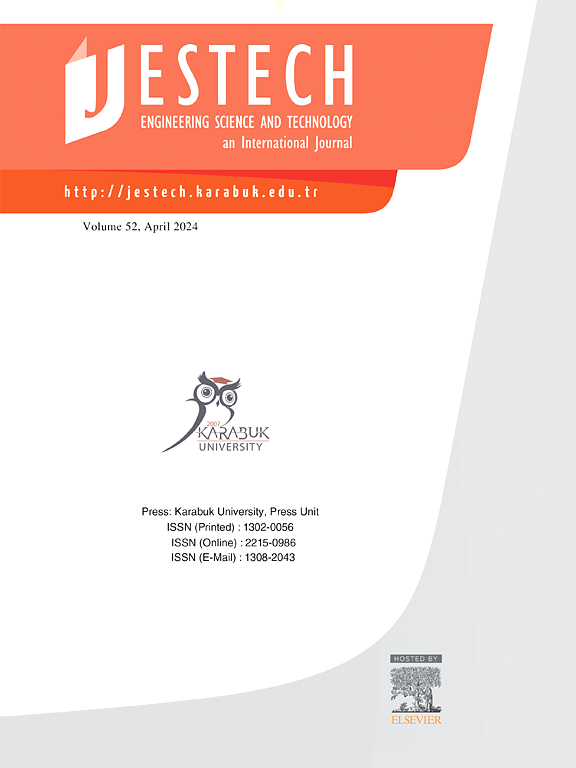Enhanced fault diagnosis of rolling bearings using attention-augmented separable residual networks
IF 5.1
2区 工程技术
Q1 ENGINEERING, MULTIDISCIPLINARY
Engineering Science and Technology-An International Journal-Jestech
Pub Date : 2025-01-01
DOI:10.1016/j.jestch.2024.101930
引用次数: 0
Abstract
Recently, with the quick development of industrial equipment automation, convolutional neural networks (CNN) have been broadly applied to the intelligent fault diagnosis of rolling bearings. In order to solve the problems of gradient vanishing, gradient explosion, and too many training parameters in deep convolutional networks that lead to low diagnostic accuracy and training efficiency of network models, a bearing fault diagnosis method based on an attention-augmented separable convolutional residual network (ASResnet) is proposed. First, the bearing vibration signal data is converted into a 2D grayscale map as an input to the network. Then, residual blocks with separable convolutions were constructed, allowing automatic learning of high-level representations from input images by stacking multiple separable convolutional residual blocks. Separable convolution effectively reduces the number of network parameters and improves computational speed. Finally, a feature extractor based on the Convolutional Block Attention Module (CBAM) is constructed so that the network focuses on the key feature regions to further improve the diagnostic performance. Validation was conducted using a Case Western Reserve University bearing dataset and three actual engineering datasets of production equipment in a cement plant. The experimental results show that ASResnet is able to improve the diagnostic accuracy and reduce the network training time of the CWRU dataset, and it also obtains a high accuracy rate in fault diagnosis for engineering applications in the cement production equipment industry.
求助全文
约1分钟内获得全文
求助全文
来源期刊

Engineering Science and Technology-An International Journal-Jestech
Materials Science-Electronic, Optical and Magnetic Materials
CiteScore
11.20
自引率
3.50%
发文量
153
审稿时长
22 days
期刊介绍:
Engineering Science and Technology, an International Journal (JESTECH) (formerly Technology), a peer-reviewed quarterly engineering journal, publishes both theoretical and experimental high quality papers of permanent interest, not previously published in journals, in the field of engineering and applied science which aims to promote the theory and practice of technology and engineering. In addition to peer-reviewed original research papers, the Editorial Board welcomes original research reports, state-of-the-art reviews and communications in the broadly defined field of engineering science and technology.
The scope of JESTECH includes a wide spectrum of subjects including:
-Electrical/Electronics and Computer Engineering (Biomedical Engineering and Instrumentation; Coding, Cryptography, and Information Protection; Communications, Networks, Mobile Computing and Distributed Systems; Compilers and Operating Systems; Computer Architecture, Parallel Processing, and Dependability; Computer Vision and Robotics; Control Theory; Electromagnetic Waves, Microwave Techniques and Antennas; Embedded Systems; Integrated Circuits, VLSI Design, Testing, and CAD; Microelectromechanical Systems; Microelectronics, and Electronic Devices and Circuits; Power, Energy and Energy Conversion Systems; Signal, Image, and Speech Processing)
-Mechanical and Civil Engineering (Automotive Technologies; Biomechanics; Construction Materials; Design and Manufacturing; Dynamics and Control; Energy Generation, Utilization, Conversion, and Storage; Fluid Mechanics and Hydraulics; Heat and Mass Transfer; Micro-Nano Sciences; Renewable and Sustainable Energy Technologies; Robotics and Mechatronics; Solid Mechanics and Structure; Thermal Sciences)
-Metallurgical and Materials Engineering (Advanced Materials Science; Biomaterials; Ceramic and Inorgnanic Materials; Electronic-Magnetic Materials; Energy and Environment; Materials Characterizastion; Metallurgy; Polymers and Nanocomposites)
 求助内容:
求助内容: 应助结果提醒方式:
应助结果提醒方式:


